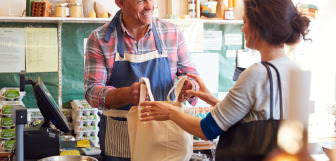Consumer Spending Continues to Rise in 2022
Merchants are slowly seeing a steady growth more akin to those seen in the 2010s [1]. As a result, many will be on the lookout to see where consumers will spend their monies.
What does rising consumer spending mean for business?
There are dozens of important factors that influence the disposable income available to a population which ultimately determines consumer spending. A cost of living crisis is being widely publicised, and the conflict in Ukraine has led to more of people’s income being spent on fuel.
But despite this, the UK's low unemployment rate and rising interest rates are likely to counterbalance such crises and encourage consumer spending further into the year. The Bank of England has now set interest rates at 1.25%, the highest for thirteen years, and businesses will be encouraged by this news[2].
Put simply, in most businesses, higher consumer spending indicates confidence in the economy and more money being spent by customers in most kinds of businesses. There are some sectors less affected than others by this, such as essential services that people cannot afford not to spend on or utilities and food. But even these sectors can notice the difference when people are saving more than usual.
Most industries watch consumer spending closely as a way of predicting future trade and guiding business decisions. The 2020s have seen many changes that are indicative of people’s new expectations and interests following a difficult start to the decade. So what are the most recent changes in consumer behaviour, and which industries are receiving a boost as a result?
Consumer spending trends 2022
An on-demand, improved convenience service
One of the most noticeable hangovers from the pandemic has been the normalisation of on-demand services. Delivery services boomed through the early 2020s while most other industries were struggling to maintain any kind of momentum. Meanwhile, companies that could deliver their products and services virtually, did so, which resulted in rapid service that required just a few minutes of download or a software update.
The result is a growing on-demand industry, up 75%[3]. More than ever, consumers in 2022 are expecting their spending to earn them instant service, anywhere and anytime. That is true from the point of making the purchase: from the moment they discover a need, they expect to pick up their mobile phone and buy it there and then. It is also true for receiving the product: they regularly expect delivery to begin immediately and to arrive the next day at the latest, or at their convenience.
Streaming services like Netflix, NowTV, Disney and Amazon are “prime” examples. Signing up takes moments, and no sooner has a customer signed up then they can access the product. But this trend extends far beyond entertainment as check-out-free stores and autonomous delivery emerges onto the retail scene and new forms of on-demand service arise[4].
On-demand groceries are beginning to transform their industry. HelloFresh and the unicorn company Gousto are taking bigger and bigger slices of the food budgets. Providing customers with all the ingredients and recipes for pre-selected meals improves nutritional quality and adds variety to diets. Delivering the food at the consumer's convenience is making the marginal increase in cost to be offset by the time saved on grocery shopping and the colour these companies bring to the kitchen.

Consumer spending predictions for these companies are very positive, and if 2022 consumer behaviour is anything to go by, on-demand grocery shopping is going to become more and more influential.
While a hard-working grocery retailer’s instincts may be to panic at the thought of greater competition (with the supermarkets already dominating the industry), Gousto and co may have shone a light on the values and expectations of the market, providing every grocer with the opportunity to fulfil that same need. 2022 grocery spending is moving towards companies with the quickest service and not just the lowest prices.
The arrival of a Generation Z with disposable income
Many parents will have come out of the pandemic and realised how much their children have matured in the time they’ve been stuck inside. Businesses are quickly realising that a new generation has entered the workplace.
The youngest of Gen Z were born in ‘97 and are now in their mid-twenties, with more money in their pocket and new values that retailers are beginning to cater to. As a generation raised with an established internet and global media, many of these values revolve around sustainability and traceable production histories.
This means that consumer behaviour in many sectors is leaning towards second-hand products, recycled products, and products with packaging that demonstrates traceable, ethical, production history. It also means products that do not require packaging are selling better, with the zero waste industry expected to rise at just under 10% by 2028[5].
Retailers will notice their younger customers questioning product packaging more and more over the coming years, so taking note of which products organisations like fairtrade give their stamps of approval will be worth the time. Although companies are noticing this and are finding ways of demonstrating their ethical production and sustainable values. Some show their circularity on the packaging while others are providing clear disposal instructions to help consumers spend and consume responsibly.
A fast-changing, fast-growing environment
The retail landscape has changed dramatically over the past few years, and industry and consumer surveys such as Adyen’s “Expectation Gap” study are showing many businesses are struggling to adapt to these changes[6].
The study showed big gaps between consumer and business values, for instance with a UK-wide 18% discrepancy on environmental impact as a concern.
However, one would expect omnichannel sales capabilities to rank higher among businesses than consumers, yet the study showed a 23% gap in consumers’ favour when it comes to buying online and returning in-store.
Retailers that provide online and in-store options for their customers will be optimising their sales capabilities while operating more aligned to market expectations. Though it has taken time, most corporations are catching up to the changes that have occurred in retail. The long-awaited launch of Primark’s website shows that even giants that have been dragging their heels are accepting the need to operate in a modern environment[7].
With spending on the rise, 2022 is sure to provide many opportunities for retailers to capitalise on fast-changing consumer trends that have left established giants vulnerable and created a mobile and exciting environment.



